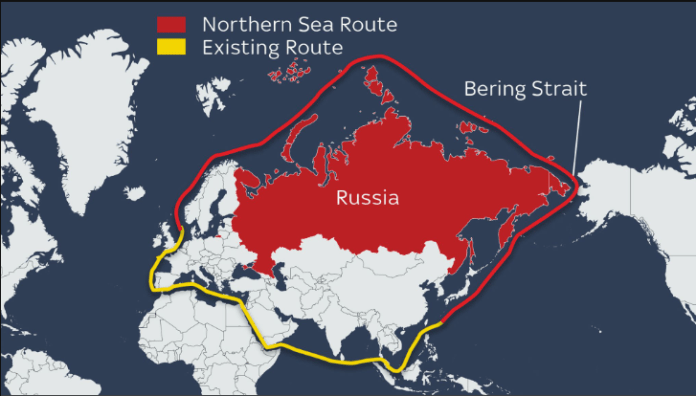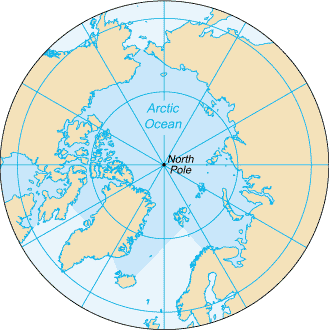
On 14th October, the “Russian-Chinese Commission for the Preparation of Regular Meetings of Heads of Government” convened its second meeting of the “Sub-Commission for Cooperation on the Northern Sea Route (NSR)” in Harbin of People’s Republic of China. The action plan for the expansion of shipping between the two countries via the Northern Sea Route was accepted after the meeting.
The goal of the roadmap’s development and approval was to create a sustainable transit corridor. The collaboration entails the application of innovative technology and logistics to boost capital projects and shipment efficiency.
🇷🇺🇨🇳 Russia and China sign Northern Sea Route COOPERATION deal
Russia’s nuclear agency Rosatom and the Chinese government will implement new technologies and develop joint projects to form a sustainable trade route between the countries pic.twitter.com/u9cX1vXYrw
— RT (@RT_com) October 14, 2025
Alexey Likhachev, Director General of Rosatom State Corporation who participated in the crucial event stated, “Russia sees the Northern Sea Route as a key transport artery of the 21st century, capable of providing faster, more efficient and safer connections between continents.”
Rosatom, Russia’s State Atomic Energy Corporation, is the organisation that runs 8 massive nuclear-powered icebreakers, the only ones of their kind in the world, through the Arctic Ocean’s frozen territories. Russia has over 40 icebreakers working in the Arctic. 4 more nuclear-powered ones are under construction.
Russia operates world’s LARGEST and most ADVANCED fleet of icebreakers, totaling over 40
8 are nuclear-powered giants, with 4 more under construction
Fleet is bigger than that of all NATO countries combined pic.twitter.com/ongqnJGZjG
— RT (@RT_com) August 29, 2025
“I am confident that the decisions taken today will give additional impetus to the development of Russian-Chinese cooperation in developing the potential of the Northern Sea Route and will allow us to materialise opportunities for cooperation in major capital projects. Our cooperation allows us not only to diversify global trade routes, but also to introduce advanced technologies in the development of high latitude areas with specific conditions,” he further mentioned.
Interestingly, global warming has made it possible for ships to travel the new route which passes through Arctic waters and inside Russia’s exclusive economic zone.
A landmark development in shipping operations
The Northern Sea Route is the primary maritime route in the Russian part of the Arctic Ocean and is a historically significant national transportation corridor. It extends throughout the Barents, Kara, Laptev, East Siberian, Chukchi, and Bering seas as well as the northern Russian shoreline. It unifies Siberia’s navigable rivers and ports in the Far East Russia alongside Europe into a single transportation network
It is the shortest shipping course connecting the western portion of Eurasia with the Asia-Pacific area. The route is roughly 5,600 kilometres long linking Providence Bay and the Kara Strait. With about 37.9 million tonnes of cargo handled in 2024, it set another record surpassing the previous year’s benchmark by over 1.6 million tonnes. Notably, transportation of containers between China and Russia is increasing in volume.
The summer-autumn navigation season of 2024 witnessed 14 international container journeys between the ports of northwest Russia and ports of China. This is double the number from 2023. Out of the 22 container journeys scheduled for this year, 17 have already been completed since the start of 2025 and 280,000 tonnes of container cargo have been moved, setting a new milestone. This represents an almost 59% increase over the 176,000 tonnes of freight transported over the entire previous year.

The partners now want to boost Northern Sea Route freight volume to 20 million tonnes by 2030. “We haven’t just set each other the goal of bringing (freight traffic) volumes to 20 million tons by 2030, our roadmap details various areas (of cooperation),” Likhachev highlighted. “It involves implementing modern logistics and technological solutions to increase shipping efficiency and support the development of major projects,” he mentioned.
“The cooperation between Russia and China in the coming years will affect not only seafaring and navigation, but also the creation of Arctic-class cargo ships, personnel training, as well as other areas,” the chief executive officer added. Russia and China hope to surpass 400,000 tonnes of containers, achieving a new record for container transportation through the Northern Sea Route.
The two nations decided to form a panel devoted to the development of the route earlier last year and the charge was handed over to Chinese Minister of Transportation and Rosatom. The subcommittee intends to transit 50 million tonnes of cargo annually along the pathway.
A polar silk route: Why is the NSR important
The Northern Sea Route has five major ports named Sabetta, Dudinka, Khatanga, Tiksi and Pevek. It starts at the boundary between the Kara and Barents Seas and closes in the Bering Strait. It was first accessed by a ship without an icebreaker in 2017 but has been in operation since the middle of the 1930s. Now, it accommodates ice class ships.
It already demonstrated its ability to handle substantial cargo transport volumes when an estimated 35 million tonnes was shipped in 2021, nearly 4.5 times more than in 2016. The year recorded that the cargo volume surpassed the USSR’s (Union of Soviet Socialist Republics) statistics for the first time as 6.57 million tonnes were transported along the route in 1987.
🇷🇺🇨🇳 Russia and China sign the Northern Sea Route cooperation deal.
The Northern Route saves 7,000km on Asia-Europe maritime transit, reduces shipping time by almost 40%.
With Russia’s frozen Northern Sea opening up to climate, it’s looking to dominate the new trade route. pic.twitter.com/Oe8aWvf7SQ
— Spetsnaℤ 007 🇷🇺 (@Alex_Oloyede2) October 14, 2025
The Northern Sea Route has several considerable advantages. It is about 40 per cent shorter than the Suez Canal (21,000 kilometres) and at least10 to 15 days faster than the Northern Europe to China route (12,800 kilometres). Likewise, it is also 60 per cent shorter than the route through the Cape of Good Hope.
The NSR also enables for the generation of revenue from return goods travelling from the Far East and is free from pirate hazards or delays as compared to other congested routes.
Russia occupies more than 53% of the coastline of the Arctic Ocean. The route functions for transit shipping and the delivery of essential goods to 2.5 million people in remote Russian territories through the Northern Supply initiative, a yearly program designed to supply the Far North’s population with necessities including food and fuel for the long and harsh polar winters.
3️⃣ NO INTERRUPTIONS
Unlike routes controlled by European states, which frequently halt shipments for various reasons, the NSR remains uninterrupted—perfect for seamless international trade. pic.twitter.com/zHg79Y58bD
— Sputnik (@SputnikInt) September 24, 2025
The shortened transit times are even slated to save emissions by 20-30 million tonnes a year and be cost effective. Moreover, the route is uninterrupted, making it ideal for smooth international trade, in contrast to those governed by European governments which regularly stop shipments for a variety of reasons.
Chinese ship reduces EU delivery time on first voyage
The first container transit from China to Europe via the Northern Sea Route left Ningbo on 23rd September and reached a United Kingdom port on 13th October. It only took 20 days to travel through the Russian Arctic which is almost half the time of more conventional southern routes.
🇷🇺🚢 RUSSIA’S NORTHERN SEA ROUTE: THE UNMATCHED SHIPPING LANE
China has just launched the Istanbul Bridge, a cargo vessel heading to the UK via the Northern Sea Route (NSR), highlighting just how critical this lane has become.
But why is the NSR such a game-changer? pic.twitter.com/J4dQToJh7f
— Sputnik (@SputnikInt) September 24, 2025
A storm off the coast of Norway caused the Istanbul Bridge’s first voyage which was initially scheduled to take 18 days, to be delayed by two days. However, it arrived in Europe sooner than the 40 to 50 days that freighters have to travel through the Suez Canal or around the Cape of Good Hope.
The ship which was carrying about 4,000 containers from the Chinese port of Zhoushan, moored in Britain’s largest container port named Felixstowe with stops planned in Germany, Poland and the Netherlands. Sea Legend, a container line under Chinese control operates the vessel.
China is pursuing faster maritime ties with the European Union, the third-largest economy in the world as it is embroiled in an expensive trade war with the United States. Beijing has increased the nautical cooperation with Russia in the Arctic in recent years while it looks for a different shipping route to lessen its reliance on the Southeast Asian Strait of Malacca.
Opportunities in the Arctic
Modern technology, particularly the development of stronger icebreakers has made it possible to reach previously unreachable or isolated areas and to travel shorter distances across the Arctic. It is anticipated that the technological prowess would create new avenues for commercial shipping throughout the water body, including the possibility of year-round navigation along the route.
The Arctic which contains vast natural reserves is also appealing to countries and industry in terms of development due to rising commodity prices and an expanding worldwide need for resources. The promise of faster shipping and easier access only serves to reinforce this attraction.

Similarly, China considers the treasure trove of untapped energy and vital mineral resources of the Arctic as essential for protecting its economy from potential energy supply interruptions and geopolitical shocks, especially in the light of its fued with the United States. The Northern Sea Route will also benefit Russia’s oil and natural gas discoveries in the ocean.
Struggle for supremacy
The Northern Sea Route is currently one of the most significant and increasingly feasible commercial initiatives of the twenty-first century, specifically amid the return of the United States President Donald Trump and the escalating geopolitical tensions over the Arctic.
The Arctic is a primary factor behind Trump’s desire to take control of Greenland. The third-largest island in the world has enormous geopolitical, strategic and economic importance because of its exceptional location and resources. Due to its location between the Atlantic and Arctic oceans, Greenland is situated along critical air and sea routes which link Europe with North America.
It is a key actor in the rapidly changing Arctic region where melting ice brought on by climate change has opened up both opportunities and challenges, as a result its proximity to the Arctic Circle. The Arctic Circle which spans around 20% of Russia’s area and runs through the country from west to east. Major cities are located in this area as it is home to millions of Russians.
Hence, the position of Greenland amplifies its military value for space surveillance, missile defence and monitoring on naval operations in the North Atlantic and Arctic.
Trump wants the country because of its unmatched dominance over the North Atlantic and Arctic which is pivotal for the US to maintain surveillance and counter North Korean, Chinese and Russian activity in the area. Greenland would also bolster US project power into the High North and contribute to its influence in the Arctic commerce lanes.
Therefore, Washington which has regularly expressed concerns about Russia’s increasing influence and control over Arctic trade is also keeping an eye on the recent situation in the Northern Sea Route.
India’s Arctic Strategy and the Northern Sea Route: Another dimension to India-Russia friendship
A senior official at Russia’s State Atomic Energy Corporation, Rosatom, informed that Russia and India are in talks to work together to construct ice-class ships that can carry goods along the Northern Sea Route. Russia wants India’s involvement in the NSR and has already approached Delhi for it.
According to Vladimir Panov, Rosatom’s special representative for Arctic Development, discussions with New Delhi also involve collaboration on crew training for cutting-edge Arctic-class ships. He conveyed Russia is in favour of signing a bilateral pact on this matter.
“Cooperation with India on the Northern Sea Route is carried out within the framework of the intergovernmental format, the Russian-Indian Working Group on Cooperation in the Northern Sea Route under the Intergovernmental Russian-Indian Commission on Trade, Economic, Scientific, Technical and Cultural Cooperation. The first meeting of the Working Group took place on 10th October 2024 in New Delhi,” Panov pointed out.
He outlined that increasing freight traffic between the two nations along the route is the primary objective of the partnership.
Notably, union minister Dr. Jitendra Singh already unveiled India’s Arctic strategy in 2022 with the title “India and the Arctic: building a partnership for sustainable development.” It included six pillars including expanding national capacity building in the Arctic region, governance and international cooperation, economic and human development, transport and connectivity, climatic and environmental protection alongside bolstering India’s scientific research and collaboration.
Finally, India has expressed interest in helping Russia develop the Northern Sea Route as an alternative to Suez Canal route. https://t.co/qLP7xvQgXv pic.twitter.com/ll7X6Z0Mag
— Dimitri Simes Jr. (@DimitriASimes) June 14, 2022
“The Northern Sea Route is not just a new shipping lane, it’s the last major addition to global marine logistics for the next few centuries. Given the instability in traditional maritime corridors like the Red Sea and the rising threat of piracy in Southeast Asia, it offers a safe and efficient alternative. India, as a trusted long-term partner of Russia, has a vital role to play in this transformation,” Panov asserted while talking to NDTV.
Modern Arctic-class ships, particularly high-ice-class container ships that can navigate all year round are needed for the same. Joint novel projects are reportedly going to develop these vessels. There is a direct cargo link between Chennai and Vladivostok, an important Russian port on the route. Chennai might be developed as a massive cargo aggregation centre for containerised shipments to Russia, as the volume of cargo between the two countries is already growing.
A specialised shipping service between Chennai and Vladivostok requires a minimum of 100 containers every week. Russian President Vladimir Putin is scheduled to visit India in December when he is likely to discuss the route and infrastructure development.
During PM Narendra Modi’s visit to Moscow in July 2024, India and Russia agreed to establish a joint working group under their intergovernmental commission to explore cooperation in Arctic shipping.

















































